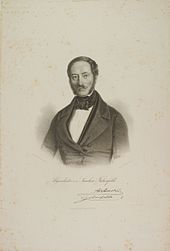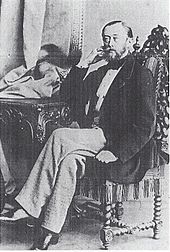Saucken (noble family)
Saucken , also Sauken , is the name of an old Prussian noble family . The family, some of whose branches still exist today, belongs to the ancient nobility in Old Prussia .
According to Kneschke , there is no tribal relationship to the Saucken family, including Sauken or Sawken, who were still wealthy in Lauenburg in the middle of the 17th century and have a different coat of arms (in blue three silver rivers flowing across each other, from which a crab crawls). Micraelius counts this family to the free Pomeranian noble families .
history
origin
The family with the brothers Niklas and Santyrme zur Wickrau (also Nikolaus and Santtir von der Wickrau ) is mentioned for the first time in a document from the year 1339. They were prescribed Groß- and Klein Wickerau as well as Luxeten. In 1384 Sander von Wickrau appeared in a document, to whom several hooves were prescribed to Podangen . The genealogical handbook of the nobility begins the uninterrupted line of trunks of the family with Bartusch von Saucken on Wickerau and Woritten. He appears in a document from 1470 and died in 1520.
According to the yearbook of the German nobility , the von Saucken were a branch of the old Prussian family von der Wickerau, which became extinct at the end of the 15th century and therefore also related to the von Kindwangen family, which died out at the beginning of the 17th century, and the von Krockow family , who were also black Hifthorn in the coat of arms. As ancestor is Barcz of Saucken called (1459 *) on Wickerau, barrettes and Woritten. He was a mercenary of the Teutonic Order and died in the war in Mohrungen in 1470.
By marrying a daughter from the originally Alsatian and later East Prussian noble family von Kuenheim , a descendant of Georg von Kuenhein († 1611) and his wife Margarete von Kunheim († 1570), the youngest daughter of Martin Luther , the relationship with the great reformer passed on to von Saucken.
In 1922 a family association was founded in Königsberg .
Spread and personalities
Peter von Saucken auf Groß- and Kleinwickerau, Thungen and Podangen, a grandson of Barcz, died in 1581 as a pledgee on Luxeten. He married Katharina von Bartsch from the Demuth family . Her son Heinrich von Saucken on Wickrau and Woritten appears in documents from 1592, became the tenant of the Borchersdorf Chamber of Commerce and married Magdalena von Parthein. Their great-grandson Wilhelm Fabian von Saucken (* around 1688) on Wickerau, Paulken and Karneyen (the latter two are now districts of Miłakowo ) was pledgee on Gudnick as well as district administrator and administrative administrator in Prussian-Holland . He died in 1749 as an imperial Russian captain . The sons from his two marriages with Maria Elenora von Frankenberg and Ludwigsdorf from the house Dalbersdorf (1700–1732), closed in 1719, and Theodora Elisabeth von Hohendorff († 1758) from the house Körnen, closed in 1735, became the founders of the two lines of the Family.
First line
Alexander Christoph von Saucken (1724–1762) on Wickerau with Paulken and Karneyen, large and small children, was the founder of the first line. He entered as a cadet in holstein-gottorpsche services and married in 1753 Sophie Albertine von der Groeben out of the house Ponarien (1732-1785). Her only son, Ernst Wilhelm Christoph von Saucken (1758–1817) in Wickerau and Paulken in the former Prussian Holland district , Karneyen in the Mohrungen district and Tarputschen in the Darkehmen district , last served as a Prussian lieutenant in the “Posadowsky” dragoon regiment . His marriage to Christine Amalie Austin (1764-1833) in 1786 resulted in ten children, three daughters and seven sons.
Of the sons, Ernst Friedrich von Saucken (1791–1854) became a Prussian cavalry master on Tarputschen and Tatars in the Darkehmen district and Georgenfelde and Schönwiese in the Gerdauen district . He last served in the 2nd West Prussian Dragoon Regiment. From his 1816 marriage with Louise von Heyligenstädt (1792-1832) emerged Karl Ernst von Saucken-Georgenfelde (1822-1871), who was a member of the Prussian House of Representatives from 1861 to 1866 and from 1867 to 1870 . From 1867 to 1871 he was also a member of the Reichstag of the North German Confederation . His brother Kurt von Saucken-Tarputschen (1825–1890) studied law and from 1878 to 1884 was regional director of the province of East Prussia . From 1862 to 1887, with a brief interruption, he was a member of the Prussian House of Representatives and from 1874 to 1884 a member of the German Reichstag . Kurt married his cousin Lina Johanna Emilie Amalie von Saucken in 1849 . Her son Ernst von Saucken (1856–1920) was an important East Prussian painter.
August Heinrich von Saucken (1798–1873) on Julienfelde in the Darkehmen district, a younger brother of Ernst Friedrich, became a general councilor. His marriage to Karoline von Below (1804–1871) in 1825 resulted in a son and three daughters. August 1852 was involved in the duel Vincke – Bismarck as a second of Georg von Vincke . Constance von Saucken (1826-1891) on Julienfelde, the couple's son, was in the state justice service until 1857 and a member of the Prussian House of Representatives until 1882. From 1874 to 1878 he was a member of the German Reichstag. His aunt Friederike Elenore von Saucken (1787–1830), the eldest sister of August Heinrich and Ernst Friedrich, married the later Prussian Lieutenant General Karl August von Esebeck (1786–1871) and Amalie Ernestine Emilie von Saucken (1795–1858), one of them Another aunt, married the later Prussian infantry general Karl Christian von Weyrach (1782–1869) in 1814 .
Second line
Abraham Wilhelm von Saucken (1741-1818), the half-brother of Alexander Christoph, was the founder of the second line of the family. He married Anna Maria von der Goltz . From the marriage, Friedrich Heinrich Wilhelm von Saucken (* 1762) came to Neu Astrawischken, later also to Raudischken in the Gerdauen district, who was retired as a Prussian lieutenant in 1828 . D. passed away. His marriage to Elenora Elisabeth Sophie von Oldenburg (1767–1841) in 1787 resulted in seven children, six sons and one daughter. Of the sons, Wilhelm Leopold Gustav Adolf von Saucken (1791-1858) was in Raudischken, later on Lochen in the district of Preussisch Eylau , Prussian cavalry master, most recently in the 2nd West Prussian Dragoon Regiment. He married Elfriede Friederieke Wilhelmine de la Chevallerie (1803-1870) in Königsberg in 1821. Their son Ernst Wilhelm Oskar von Saucken (* 1833; † 1910) was a Prussian captain, district administrator, member of the Prussian House of Representatives and the General Synod, as well as a legal knight of the Order of St. John .
Karl Wilhelm August Eduard von Saucken (* 1793) in Raudischken, Kaukern in the district of Insterburg and Reussen in the district of Angerburg , the brother of Wilhelm Leopold Gustav Adolf, died in 1865 as a Prussian lieutenant a. D. and last served in the 8th Infantry Regiment . His marriage to Anna Josepha Paris (1799–1865) in Egeln in 1819 resulted in three sons. Anna Josepha and Karl Wilhelm August Eduard were the great-grandparents of Dietrich von Saucken (1892-1980), son of the Prussian government councilor Wilhelm Eduard Erich von Saucken (* 1858) and his wife Berta Marie Westphal (* 1862), who during the Second World War to General of the armored forces was promoted. As the bearer of the diamonds for the Knight's Cross of the Iron Cross , he was one of the 27 most highly decorated soldiers in the Wehrmacht .
coat of arms
Family coat of arms
The coat of arms shows a black eagle in gold on a black hunting horn . On the helmet with black and gold helmet covers a resting black hunting horn with a black (also gold) cord looped upwards.
The coat of arms, so emblazoned and depicted here, has been consistently used since 1930 according to a family decision.
Coat of arms history
The coat of arms appears on more recent seal impressions , older ones are not known. The representation of the horn in particular varies there. Older pictures also show the black horn in the golden field alone.
According to the Jahrbuch des Deutschen Adels (1898) Volume 2, pp. 380–394, an older form of the coat of arms in gold shows a black eagle over a black hunting horn resting in the base of the shield . On the helmet with black and gold covers a resting black hunting horn (also with a golden loop wound upwards). A newer form shows a gold-armored black eagle in blue, which is holding a golden hunting horn with a golden loop wound upwards in its claws. On the helmet with a blue and gold cover a golden hunting horn as in the shield .
At Ledebur the lexicon of the Prussian monarchy . (1856) Volume 2, pp. 342–343, the coat of arms in silver shows a black hunter's horn with gold fittings and a gold ribbon, on which there is a black eagle. The hunter's horn is repeated on the helmet. In Kneschke's New General German Adels Lexicon (1868) Volume 8, pp. 54-55, the von Saucken wear a black hunter's horn in silver with gold fittings and ribbons, with a black eagle on it.
Known family members
- Arthur von Saucken (* 1852, † 1938), Prussian lieutenant general
- August von Saucken-Julienfelde (* 1798; † 1873), politician
- Dietrich von Saucken (* 1892; † 1980), German general of the tank troops
- Ernst Friedrich Fabian von Saucken-Tarputschen (* 1791; † 1854), member of the Frankfurt National Assembly
- Ernst von Saucken (* 1856; † 1920), East Prussian painter and composer
- Karl von Saucken (* 1822, † 1871), East Prussian manor owner and politician
- Constance von Saucken-Julienfelde (* 1826, † 1891), landowner and member of the Reichstag
- Kurt von Saucken-Tarputschen (* 1825; † 1890), lawyer
- Oskar von Saucken (* 1833, † 1910), landowner and member of the Prussian House of Representatives
- Reinhold von Saucken (* 1899; † 1966), German diplomat and consul general
literature
- Leopold von Ledebur : Nobility Lexicon of the Prussian Monarchy . Volume 2, Ludwig Rauh, Berlin 1856, pp. 342–343, ( digitized version )
- Ernst Heinrich Kneschke : New general German nobility lexicon . Volume 8, Friedrich Voigt's Buchhandlung, Leipzig 1868, pp. 54–55. ( Digitized version )
- Deutsche Adelsgenossenschaft (Hrsg.): Yearbook of the German nobility . Volume 3, 1899, published by WT Bruer, p. 380, digitized
- Franz Menges : Saucken, from. In: New German Biography (NDB). Volume 22, Duncker & Humblot, Berlin 2005, ISBN 3-428-11203-2 , p. 450 ( digitized version ).
- Genealogisches Handbuch des Adels , Adelslexikon Volume XII, Volume 125 of the complete series, p. 265, CA Starke Verlag , Limburg (Lahn) 2001, ISSN 0435-2408
Individual evidence
- ↑ a b New general German nobility lexicon. Volume 8, pp. 54-55.
- ^ Prussian State Archives in Königsberg in the Secret State Archives of the Prussian Cultural Heritage Foundation , Order Foliant 91
- ↑ a b c d e Yearbook of the German Nobility . Volume 3, WT Bruer, Berlin 1898, pp. 380-394.
- ↑ a b c Genealogical manual of the nobility . Adelslexikon Volume XII, Volume 125 of the complete series, p. 265.
- ↑ Otto Hupp : Munich Calendar 1923. P. 30.
- ^ Johann Siebmacher's large book of arms from 1857. Volume 14, The arms of the Prussian nobility , Part 1, Volume 2, p. 346, Reprint Bauer & Raspe 1973.
- ^ Aristocratic lexicon of the Prussian monarchy . Volume 2, pp. 342-343.





